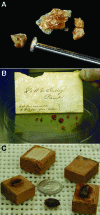Poxvirus viability and signatures in historical relics
- PMID: 24447382
- PMCID: PMC3901489
- DOI: 10.3201/eid2002/131098
Poxvirus viability and signatures in historical relics
Abstract
Although it has been >30 years since the eradication of smallpox, the unearthing of well-preserved tissue material in which the virus may reside has called into question the viability of variola virus decades or centuries after its original occurrence. Experimental data to address the long-term stability and viability of the virus are limited. There are several instances of well-preserved corpses and tissues that have been examined for poxvirus viability and viral DNA. These historical specimens cause concern for potential exposures, and each situation should be approached cautiously and independently with the available information. Nevertheless, these specimens provide information on the history of a major disease and vaccination against it.
Keywords: artifacts; historical relics; mummies; orthopoxvirus; poxvirus; signatures; smallpox; smallpox virus; vaccinia; variola; viability; viruses.
Figures



References
-
- Fenner F, Henderson DA, Arita I, Jezek Z, Ladnyi ID. Smallpox and its eradication. Geneva: World Health Organization; 1988.
-
- Hopkins DR. Ramses V. Earliest known victim? World Health. 1980, May 22 [cited 2013 Dec 2]. http://whqlibdoc.who.int/smallpox/WH_1980.pdf
Publication types
MeSH terms
Substances
LinkOut - more resources
Full Text Sources
Other Literature Sources
Medical

